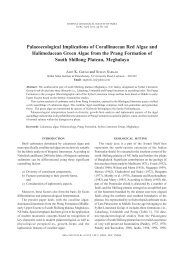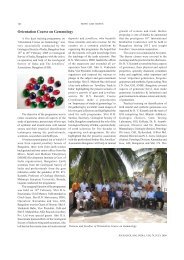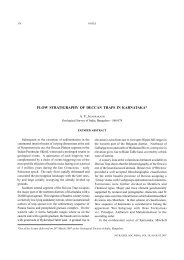Full text in PDF - Geological Society of India
Full text in PDF - Geological Society of India
Full text in PDF - Geological Society of India
You also want an ePaper? Increase the reach of your titles
YUMPU automatically turns print PDFs into web optimized ePapers that Google loves.
404 ANIKET CHAKRABARTY AND AMIT KUMAR SEN<br />
to the low-temperature fluids derived from a fractionated<br />
magma dom<strong>in</strong>ated by CO 2<br />
also conta<strong>in</strong><strong>in</strong>g fluor<strong>in</strong>e and H 2<br />
O<br />
<strong>in</strong> variable proportions.<br />
Occurrence <strong>of</strong> small bodies <strong>of</strong> carbonatite and alkal<strong>in</strong>e<br />
rocks like nephel<strong>in</strong>e-syenite is known s<strong>in</strong>ce last two decades<br />
along 100 Km long Northern Shear Zone (NSZ) traced from<br />
Khatra <strong>in</strong> Bankura, West Bengal to Tamar <strong>in</strong> Jharkhand<br />
through Beldih, Med<strong>in</strong>itanr, Kutni, Chirugora, Sush<strong>in</strong>a, and<br />
Tamakhun (Fig. 1) (Kumar et al. 1985; Basu, 1993, 2003;<br />
Chakrabarty et al. 2009).These rocks are <strong>in</strong>truded with<strong>in</strong><br />
the Chandil formation <strong>of</strong> 1.5-1.6 Ga age and lies <strong>in</strong> the close<br />
proximity <strong>of</strong> the Chotanagpur Granite Gneissic Complex<br />
(CGGC). The alkal<strong>in</strong>e rocks exposed <strong>in</strong> different areas along<br />
the NSZ are Beldih (carbonatite, alkali-pyroxenite, and<br />
apatite-magnetite), Kutni (carbonatite, apatite), and Sush<strong>in</strong>a<br />
(nephel<strong>in</strong>e syenite gneiss) (S<strong>in</strong>gh et al. 1977; Ghosh Roy<br />
and Sengupta, 1988; Basu, 1988, 1989, and 1990). The<br />
exposure <strong>of</strong> the carbonatite is found only at Beldih (Purulia<br />
district, W.B.), the present area <strong>of</strong> <strong>in</strong>vestigation and<br />
henceforth will be termed as ‘Purulia carbonatite’. The<br />
<strong>Geological</strong> Survey <strong>of</strong> <strong>India</strong> had also reported other<br />
occurrences <strong>of</strong> carbonatite from Mednitanr and Kutni<br />
areas based on drill-core samples (Basu, 1993). This shear<br />
zone is also known for host<strong>in</strong>g different m<strong>in</strong>eralization like<br />
Nb, apatite-magnetite, REE. The usual silicate rock<br />
association <strong>of</strong> magmatic carbonatite such as nephel<strong>in</strong>ite,<br />
melilitolite, ijolites, urtites, kimberlites is absent <strong>in</strong> Beldih.<br />
Instead, the carbonatite is associated with the alkalipyroxenite<br />
and a large apatite-magnetite ore body; a case<br />
similar to the famous Khib<strong>in</strong>a Complex <strong>of</strong> Russia (Zaitsev<br />
et al. 1998). Such similarity <strong>in</strong>vokes a possible genesis <strong>of</strong><br />
Beldih carbonatite as carbothermal residua <strong>of</strong> unknown<br />
parentage (Woolley and Kjarsgaard, 2008). In view <strong>of</strong> such<br />
possibilities, the genesis <strong>of</strong> the Purulia carbonatite and their<br />
possible genetic (?) l<strong>in</strong>eage with the other silicate rocks<br />
present along the NSZ is important and leads to the present<br />
<strong>in</strong>vestigation. The <strong>in</strong>vestigation is based on detailed<br />
petrography and trace element geochemistry <strong>of</strong> the Purulia<br />
carbonatite. Three major rock types are found <strong>in</strong> this area<br />
and are carbonatite, alkali-pyroxenite and apatite-magnetite<br />
rock.<br />
Carbonatites<br />
PETROGRAPHY AND MINERALOGY<br />
The carbonatite is a light colored, medium-gra<strong>in</strong>ed rock<br />
composed essentially <strong>of</strong> subhedral to euhedral calcite<br />
(~ 90% by volume, see Table 1 for detail modal compositions)<br />
with appreciable amounts <strong>of</strong> apatite (Table 1),<br />
altogether exhibit<strong>in</strong>g mosaic <strong>text</strong>ure. The accessory m<strong>in</strong>eral<br />
Fig.1. (a) Regional geological map <strong>of</strong> the study area. (b) Generalized stratigraphic succession <strong>of</strong> the S<strong>in</strong>ghbhum region show<strong>in</strong>g the<br />
status <strong>of</strong> the Chandil Formation along with the rocks <strong>of</strong> S<strong>in</strong>ghbhum Group.<br />
JOUR.GEOL.SOC.INDIA, VOL.76,OCT.2010

















